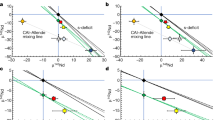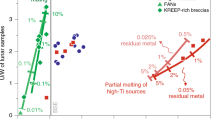Abstract
A long-standing question in the planetary sciences asks what the Earth is made of. For historical reasons, volatile-depleted primitive materials similar to current chondritic meteorites were long considered to provide the ‘building blocks’ of the terrestrial planets. But material from the Earth, Mars, comets and various meteorites have Mg/Si and Al/Si ratios, oxygen-isotope ratios, osmium-isotope ratios and D/H, Ar/H2O and Kr/Xe ratios such that no primitive material similar to the Earth's mantle is currently represented in our meteorite collections. The ‘building blocks’ of the Earth must instead be composed of unsampled ‘Earth chondrite’ or ‘Earth achondrite’.
This is a preview of subscription content, access via your institution
Access options
Subscribe to this journal
Receive 51 print issues and online access
$199.00 per year
only $3.90 per issue
Buy this article
- Purchase on Springer Link
- Instant access to full article PDF
Prices may be subject to local taxes which are calculated during checkout





Similar content being viewed by others
References
Wänke, H. Constitution of terrestrial planets. Phil. Trans. R. Soc. Lond. 303, 287–302 (1981).
Chou, C.-L. Fractionation of siderophile elements in the Earth's upper mantle. Proc. Lunar Planet. Sci. Conf. 9, 219–230 (1978).
Brearley, A. J. & Jones, R. H. in Planetary Materials. Reviews in Mineralogy Vol. 36 (ed. Papike, J. J.) 3-1–3-398 (The Mineralogical Society of America, Washington DC, 1998).
Brown, P. G. et al. The fall, recovery, orbit, and composition of the Tagish Lake meteorite: a new type of carbonaceous chondrite. Science 290, 320–325 (2000).
Drake, M. J. Accretion and primary differentiation of the Earth: a personal journey. Geochim. Cosmochim. Acta 64, 2363–2370 (2000).
Allegre, C. J., Poirer, J.-P., Humler, E. & Hofmann, A. W. The chemical composition of the Earth. Earth Planet. Sci. Lett. 134, 515–526 (1995).
Anderson, D. L. Composition of the Earth. Science 243, 367–370 (1989).
Wade, J. & Wood, B. J. The Earth's “missing” niobium may be in the core. Nature 409, 75–78 (2001).
Drake, M. J., Newsom, H. E. & Capobianco, J. C. V, Cr, and Mn in the Earth, Moon, EPB, and SPB and the origin of the Moon: Experimental studies. Geochim. Cosmochim. Acta 53, 2101–2111 (1989).
Wood, B. J. & Nell, J. High-temperature electrical conductivity of the lower-mantle phase (Mg,Fe)O. Nature 351, 309–311 (1991).
Ito, E. & Takahashi, E. Post-spinel transformations in the system Mg2SiO4–Fe2SiO4 and some geophysical implications. J. Geophys. Res. 94, 10637–10646 (1989).
Chopelas, A. & Boehler, R. Thermal expansivity in the lower mantle. Geophys. Res. Lett. 19, 1983–1986 (1992).
Tackley, P. J., Stevenson, D. J., Glatzmaier, G. A. & Schubert, G. Effects of an endothermic phase transition at 670 km depth in a spherical model of convection in the Earth's mantle. Nature 361, 699–704 (1993).
Kellogg, L. H., Hager, B. H. & Van der Hilst, R. D. Compositional stratification in the deep mantle. Science 283, 1881–1884 (1999).
Clayton, R. N. & Mayeda, T. K. Oxygen isotope signatures of hydration reactions in solar system materials. 11th Annu. V. M. Goldschmidt Conf. Abstr. no. 3648, LPI Contribution No. 1088 (Lunar and Planetary Institute, Houston, 2001).
Cameron, A. G. W. in Origin of the Earth and Moon (eds Canup, R. M. & Righter, K.) 133–144 (Univ. Arizona Press, Tucson, 2000).
Canup, R. M. & Asphaug, E. The Moon-forming impact. Nature 412, 708–712 (2001).
Weichert, U. et al. Oxygen isotope homogeneity of the Moon. Lunar Planet. Sci. Conf. 32, Abstr. no. 1669, LPI Contribution No. 1080 (Lunar and Planetary Institute, Houston, 2001).
Owen, T. & Bar-nun, A. in Origin of the Earth and Moon (eds Canup, R. M. & Righter, K.) 459–471 (Univ. Arizona Press, Tucson, 2000).
Righter, K., Drake, M. J. & Yaxley, G. Prediction of siderophile element metal/silicate partition coefficients to 20 GPa and 2800 °C: the effects of pressure, temperature, oxygen fugacity, and silicate and metallic melt compositions. Phys. Earth Planet. Inter. 100, 115–134 (1997).
Righter, K. & Drake, M. J. Metal/silicate equilibrium in a homogeneously accreting Earth: New results for Re. Earth Planet. Sci. Lett. 146, 541–554 (1997).
Righter, K. & Drake, M. J. Effect of water on metal/silicate partitioning of moderately siderophile elements: a high pressure and temperature terrestrial magma ocean and core formation. Earth Planet. Sci. Lett. 171, 383–399 (1999).
Righter, K. & Drake, M. J. Metal/silicate equilibrium in the early Earth—new constraints from volatile moderately siderophile elements. Geochim. Cosmochim. Acta 64, 3581–3507 (2000).
Okuchi, T. Hydrogen partitioning into molten iron at high pressure: implications for Earth's core. Science 278, 1781–1784 (1997).
Abe, Y., Ohtani, E., Okuchi, T., Righter, K. & Drake, M. J. in Origin of the Earth and Moon (eds Canup, R. M. & Righter, K.) 413–433 (Univ. Arizona Press, Tucson, 2000).
Morgan, J. W., Walker, R. J., Brandon, A. D. & Horan, M. F. Siderophile elements in earth's upper mantle and lunar breccias: data synthesis suggests manifestations of the same late influx. Meteor. Planet. Sci. 36, 1257–1275 (20001).
Zinner, E. in Meteorites and the Early Solar System (ed. Kerridge, J.) 956–983 (Univ. Arizona Press, Tucson, 1988).
Lecluse, C. & Robert, F. Hydrogen isotope exchange reaction rates: origin of water in the inner solar system. Geochim. Cosmochim. Acta 58, 2927–2939 (1994).
Deloule, E. & Robert, F. Instellar water in meteorites? Geochim. Cosmochim. Acta 59, 4695–4706 (1995).
Stern, S. A. et al. The discovery of argon in Comet C/1995 01 (Hale-Bopp). Astrophys. J. 544, L169–L172 (2000).
Swindle, T. D. & Kring, D. A. Implications of noble gas budgets for the origin of water in Earth and Mars. 11th Annu. V. M. Goldschmidt Conf. Abstr. no. 3785, LPI Contribution No. 1088 (Lunar and Planetary Institute, Houston, 2001).
Feldman, P. D., Weaver, H. A. & Burgh, E. B. FUSE observations of CO and H2 emission in comet C/2001 A2 (LINEAR). Bull. Am. Astron. Soc. 33, 1120 (2001).
Morbidelli, A. et al. Source regions and timescales for delivery of water to the Earth. Meteor. Planet. Sci. 35, 1309–1320 (2000).
Pepin, R. O. in Origin and Evolution of Planetary and Satellite Atmospheres (eds Atreya, S. K., Pollack, J. B. & Matthews, M. S.) 291–305 (Univ. Arizona Press, Tucson, 1989).
Jagoutz, E. et al. The abundances of major, minor and trace elements in the earth's mantle as derived from primitive ultramafic nodules. Proc. Lunar Planet. Sci. Conf. 10, 2031–2050 (1979).
Taylor, S. R. Solar System Evolution: A New Perspective (Cambridge Univ. Press, Cambridge, 1992).
Dreibus, G. et al. Relationship between rocks and soil at the Pathfinder landing site and the martian meteorites. Lunar Planet. Sci. Conf. [CD-ROM] 29, Abstr. no. 1348 (Lunar and Planetary Institute, Houston, 1998).
Ringwood, A. E. Origin of the Earth and Moon (Springer, New York, 1979).
Palme, H. & Nickel, K. G. Ca/Al ratio and composition of the Earth's primitive upper mantle. Geochim. Cosmochim. Acta 49, 2123–2132 (1986).
Clayton, R. N. & Mayeda, T. K. Oxygen isotope studies in carbonaceous chondrites. Geochim. Cosmochim. Acta 63, 2089–2104 (1999).
Clayton, R. N. Oxygen isotopes in meteorites. Annu. Rev. Earth Planet. Sci. 21, 115–149 (1993).
Clayton, R. N., Mayeda, T. K., Goswami, J. N. & Olsen, E. J. Oxygen isotope studies in ordinary chondrites. Geochim. Cosmochim. Acta 55, 2317–2337 (1991).
Meisel, T., Walker, R. J., Irving, A. J. & Lorand, J.-P. Osmium isotopic compositions of mantle xenoliths: a global perspective. Geochim. Cosmochim. Acta 65, 1311–1323 (2001).
Robert, F., Gautier, D. & Dubrulle, B. The solar system D/H ratio: Observations and theories. Space Sci. Rev. 92, 201–224 (2000).
Deloule, E., Robert, F. & Doukhan, J. C. Interstellar hydroxyl in meteoritic chondrules: implications for the origin of water in the inner solar system. Geochim. Cosmochim. Acta 62, 3367–3378 (1998).
Robert, F. The origin of water on Earth. Science 293, 1056–1058 (2001).
Acknowledgements
Supported by NASA and NSF. We thank D. Lauretta for comments. A review by T. Owen brought noble gas ratios in Solar System bodies to our attention. Discussions with H. McSween, D. Kring, R. Boehler, D. Mao, L. Stixrude, A. Morbidelli, J. Lunine, F. Robert and T. Swindle have been helpful.
Author information
Authors and Affiliations
Corresponding author
Rights and permissions
About this article
Cite this article
Drake, M., Righter, K. Determining the composition of the Earth. Nature 416, 39–44 (2002). https://doi.org/10.1038/416039a
Issue Date:
DOI: https://doi.org/10.1038/416039a
This article is cited by
-
The accretion of planet Earth
Nature Reviews Earth & Environment (2022)
-
Earth’s missing argon paradox resolved by recycling of oceanic crust
Nature Geoscience (2022)
-
Geochemical models of core–mantle differentiation
Acta Geochimica (2022)
-
Geoneutrinos and geoscience: an intriguing joint-venture
La Rivista del Nuovo Cimento (2022)
-
Nickel isotopic evidence for late-stage accretion of Mercury-like differentiated planetary embryos
Nature Communications (2021)
Comments
By submitting a comment you agree to abide by our Terms and Community Guidelines. If you find something abusive or that does not comply with our terms or guidelines please flag it as inappropriate.



